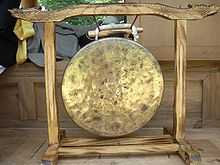Jing (instrument)
From Wikipedia, the free encyclopedia
| Jing | |
 | |
| Korean name | |
|---|---|
| Hangul | 징 |
| Hanja | 鉦 |
| Revised Romanization | jing |
| McCune–Reischauer | ching |
The jing is a large gong used in traditional Korean music, particularly in samul nori, pungmul, and daechwita. Usually made from brass, it is struck by a hammer that is layered with soft cloth to smoothen the texture of the sound produced. It is typically played at the onset of ceremonies and special occasions. It is struck with a large, padded stick and drops in pitch slightly when struck firmly.
Its name was originally pronounced jeong (정, deriving from the Sino-Korean 鉦).
See also
This article is issued from Wikipedia. The text is available under the Creative Commons Attribution/Share Alike; additional terms may apply for the media files.